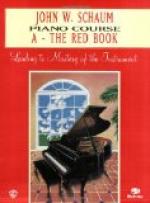My summer study with Mr. Sherwood consisted mainly in gaining ideas on the interpretation of various pieces. Many of these ideas seem to me beautiful and inspiring, and I will set them down as fully as I can from the brief notes jotted down at the time. I trust I may be pardoned a few personal references, which are sometimes necessary to explain the situation.
With advanced students Mr. Sherwood gave great attention to tone study and interpretation, even from the first lesson. He laid much stress on the use of slow, gentle motions in practise and in playing; on the spiritualization of the tones, of getting behind the notes to find the composer’s meaning. He had, perhaps, a more poetic conception of piano playing than any master I have known, and was able to impart these ideas in clear and simple language.
The first composition considered was Schumann’s Nachtstueck, the fourth of the set. He had a peculiar way of turning the hand on the middle finger, as on a pivot, for the extended chords, at the same time raising the whole outer side of the hand, so that the fifth finger should be able to play the upper melody notes round and full. In the middle section he desired great tenderness and sweetness of tone. “There are several dissonances in this part,” he said, “and they ought to be somewhat accented—suspensions I might call them. In Bach and Handel’s time, the rules of composition were very strict—no suspensions were allowed; so they were indicated where it was not permitted to write them.”
Chopin’s etude in sixths came up for analysis. “This study needs a very easy, quiet, limpid touch—the motions all gliding and sliding rather than pushing and forceful. I would advise playing it at first pianissimo; the wrist held rather low, the knuckles somewhat high, and the fingers straightened. In preparation for each pair of notes raise the fingers and let them down—not with a hard brittle touch, if I may use the word, but with a soft, velvety one. A composition like this needs to be idealized, spiritualized, taken out of everyday life. Take, for instance, the Impromptu Op. 36, Chopin; the first part of it is something like this etude, soft, undulating—smooth as oil. There is something very uncommon, spiritual, heavenly, about the first page of that Impromptu—very little of the earth, earthy. The second page is in sharp contrast to the first, it comes right down to the hard, everyday business of life—it is full of harsh, sharp tones. Well, the idea of that first page we get in this study in sixths. I don’t want the bare tones that stand there on the printed page; I want them spiritualized—that is what reveals the artist. In the left hand the first note should have a clear, brittle accent, with firm fifth finger, and the double sixths played with the creeping, clinging movement I have indicated. If I should practise this etude for half an hour, you might be surprised at the effects I could produce. Perhaps it might take ten hours, but in the end I am confident I could produce this floating, undulating effect. I heard Liszt play nearly all these etudes at one time; I stood by and turned the pages. In this etude he doubled the number of sixths in each measure; the effect was wonderful and beautiful.




